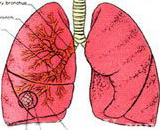Pulmonary Fibrosis (PF)
Lung Fibrosis

Pulmonary fibrosis is a respiratory disease in which scars are formed in the lung tissues, leading to serious breathing problems. Scar formation, the accumulation of excess fibrous connective tissue, leads to thickening of the walls, and causes reduced oxygen supply in the blood. As a consequence patients suffer from perpetual shortness of breath.
Models for pulmonary fibrosisis are induced by Bleomycin, pingyangmycin and paraquat in rats and mice. Bleomycin is a widely used chemotherapeutic agent causing pulmonary fibrosis. Studies suggest that lung injuries induced by monocrotaline treatment progress to irreversible lung fibrosis and that this animal model for pulmonary fibrosis may have advantage for studying the pathogenesis of lung cancers in patients with pulmonary fibrosis.
Organism species: Mus musculus (Mouse)
- Disease model DSI518Mu01 Mouse Model for Pulmonary Fibrosis (PF) In Stock
- Disease model DSI518Mu02 Mouse Model for Pulmonary Fibrosis (PF) In Stock
- Disease model DSI518Mu03 Mouse Model for Pulmonary Fibrosis (PF) In Stock
- Tissue TSI518Mu07 Mouse Tissue of Pulmonary Fibrosis (PF) In Stock
- Tissue TSI518Mu77 Mouse Tissue of Pulmonary Fibrosis (PF) In Stock
- Tissue TSI518Mu03 Mouse Tissue of Pulmonary Fibrosis (PF) In Stock
- Tissue TSI518Mu05 Mouse Tissue of Pulmonary Fibrosis (PF) In Stock
- Tissue TSI518Mu01 Mouse Tissue of Pulmonary Fibrosis (PF) In Stock
- Tissue TSI518Mu09 Mouse Tissue of Pulmonary Fibrosis (PF) In Stock
- Tissue TSI518Mu15 Mouse Tissue of Pulmonary Fibrosis (PF) In Stock
- Tissue TSI518Mu27 Mouse Tissue of Pulmonary Fibrosis (PF) In Stock
- Tissue TSI518Mu29 Mouse Tissue of Pulmonary Fibrosis (PF) In Stock
- Customized Service n/a Serums of Pulmonary Fibrosis (PF) (If Necessary) Serums Customized Service Offer
Organism species: Rattus norvegicus (Rat)
- Disease model DSI518Ra01 Rat Model for Pulmonary Fibrosis (PF) In Stock
- Disease model DSI518Ra02 Rat Model for Pulmonary Fibrosis (PF) In Stock
- Disease model DSI518Ra03 Rat Model for Pulmonary Fibrosis (PF) In Stock
- Tissue TSI518Ra07 Rat Tissue of Pulmonary Fibrosis (PF) In Stock
- Customized Service n/a Serums of Pulmonary Fibrosis (PF) (If Necessary) Serums Customized Service Offer
Organism species: Cavia (Guinea pig )
- Customized Service n/a Model for Pulmonary Fibrosis (PF) Disease Model Customized Service Offer
- Customized Service n/a Tissue of Pulmonary Fibrosis (PF) (If Necessary) Tissue Customized Service Offer
- Customized Service n/a Serums of Pulmonary Fibrosis (PF) (If Necessary) Serums Customized Service Offer
Organism species: Oryctolagus cuniculus (Rabbit)
- Disease model DSI518Rb01 Rabbit Model for Pulmonary Fibrosis (PF) In Stock
- Customized Service n/a Tissue of Pulmonary Fibrosis (PF) (If Necessary) Tissue Customized Service Offer
- Customized Service n/a Serums of Pulmonary Fibrosis (PF) (If Necessary) Serums Customized Service Offer
Organism species: Canis familiaris; Canine (Dog)
- Customized Service n/a Model for Pulmonary Fibrosis (PF) Disease Model Customized Service Offer
- Customized Service n/a Tissue of Pulmonary Fibrosis (PF) (If Necessary) Tissue Customized Service Offer
- Customized Service n/a Serums of Pulmonary Fibrosis (PF) (If Necessary) Serums Customized Service Offer


